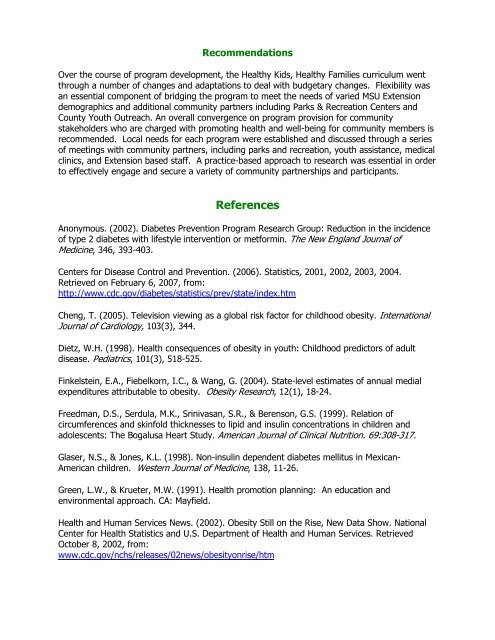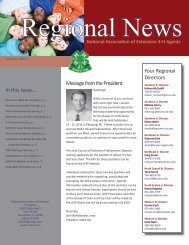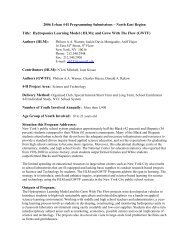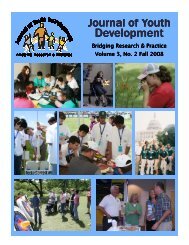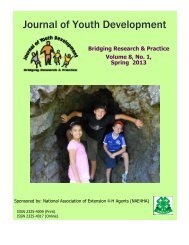Winter 2008 - Vol. 3 No. 3 - National Association of Extension 4-H ...
Winter 2008 - Vol. 3 No. 3 - National Association of Extension 4-H ...
Winter 2008 - Vol. 3 No. 3 - National Association of Extension 4-H ...
- No tags were found...
You also want an ePaper? Increase the reach of your titles
YUMPU automatically turns print PDFs into web optimized ePapers that Google loves.
RecommendationsOver the course <strong>of</strong> program development, the Healthy Kids, Healthy Families curriculum wentthrough a number <strong>of</strong> changes and adaptations to deal with budgetary changes. Flexibility wasan essential component <strong>of</strong> bridging the program to meet the needs <strong>of</strong> varied MSU <strong>Extension</strong>demographics and additional community partners including Parks & Recreation Centers andCounty Youth Outreach. An overall convergence on program provision for communitystakeholders who are charged with promoting health and well-being for community members isrecommended. Local needs for each program were established and discussed through a series<strong>of</strong> meetings with community partners, including parks and recreation, youth assistance, medicalclinics, and <strong>Extension</strong> based staff. A practice-based approach to research was essential in orderto effectively engage and secure a variety <strong>of</strong> community partnerships and participants.ReferencesAnonymous. (2002). Diabetes Prevention Program Research Group: Reduction in the incidence<strong>of</strong> type 2 diabetes with lifestyle intervention or metformin. The New England Journal <strong>of</strong>Medicine, 346, 393-403.Centers for Disease Control and Prevention. (2006). Statistics, 2001, 2002, 2003, 2004.Retrieved on February 6, 2007, from:http://www.cdc.gov/diabetes/statistics/prev/state/index.htmCheng, T. (2005). Television viewing as a global risk factor for childhood obesity. InternationalJournal <strong>of</strong> Cardiology, 103(3), 344.Dietz, W.H. (1998). Health consequences <strong>of</strong> obesity in youth: Childhood predictors <strong>of</strong> adultdisease. Pediatrics, 101(3), 518-525.Finkelstein, E.A., Fiebelkorn, I.C., & Wang, G. (2004). State-level estimates <strong>of</strong> annual medialexpenditures attributable to obesity. Obesity Research, 12(1), 18-24.Freedman, D.S., Serdula, M.K., Srinivasan, S.R., & Berenson, G.S. (1999). Relation <strong>of</strong>circumferences and skinfold thicknesses to lipid and insulin concentrations in children andadolescents: The Bogalusa Heart Study. American Journal <strong>of</strong> Clinical Nutrition. 69:308-317.Glaser, N.S., & Jones, K.L. (1998). <strong>No</strong>n-insulin dependent diabetes mellitus in Mexican-American children. Western Journal <strong>of</strong> Medicine, 138, 11-26.Green, L.W., & Krueter, M.W. (1991). Health promotion planning: An education andenvironmental approach. CA: Mayfield.Health and Human Services News. (2002). Obesity Still on the Rise, New Data Show. <strong>National</strong>Center for Health Statistics and U.S. Department <strong>of</strong> Health and Human Services. RetrievedOctober 8, 2002, from:www.cdc.gov/nchs/releases/02news/obesityonrise/htm


